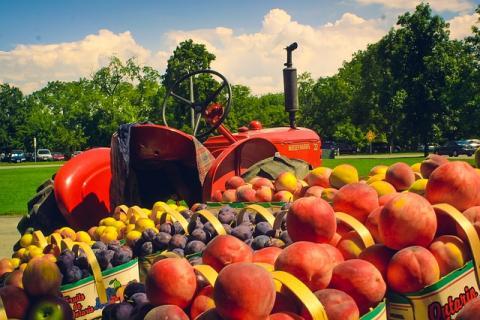
While eating your dinner, you are probably focused on the hectic day you had or listening to someone else’s rant. You might be serving everyone and holding off eating until everyone is happy. You might be proud of the meal you prepared. But did you ever think about where it all came from? Your salad could have lettuce from California. Your potatoes might be from Idaho. Your stew has ingredients from all over the world.
This isn’t necessarily bad. We live in a country where most things are accessible to us year-round, 24 hours a day. We don’t have to worry about things being “in season” anymore. You might not be able to pick blueberries in February, but you can buy them at the store. But is this luxury worth the high carbon footprint it takes to import the goods from around the world? Many people have taken a second look at their food sources and are making an effort to eat food grown as locally as possible.
“Farm to table” is a common phrase you may have heard in the restaurant industry and in communities around the United States. It is the idea of eliminating the many steps it might take for a food product to become part of your meal. Making a conscious effort to do so can boost your local economy, provide you with fresher, healthier produce, and bring the community together. Let’s explore the benefits of the farm-to-table business model.
The Benefits of Freshness and Health
Locally grown produce sold locally is allowed to ripen longer than something that has to travel thousands of miles to your store. It has more nutrients than produce picked before it ripened. Fresh produce always tastes better, and small local farmers don’t use as many pesticides as a corporate farm. The fruits and veggies don’t need preservatives to stay fresh longer, and you eat them at their peak of freshness. No need for cellophane wrappings, Styrofoam or taped boxes.
Greater Economic Opportunity
A demand for fresh, locally grown fruits and vegetables creates local jobs. The money spent on these items stays in the community and creates growth. Prices are usually comparable to those in stores but may be a little higher in some cases.
But that’s OK. The money stays in your community and enables community farming to continue. Some urban areas have reclaimed abandoned parcels of land and turned them into community gardens. Public school children learn the value of hard work by learning how to plant and harvest.
They learn about the plants they grow and food safety. They get on-the-job business skills as they learn how to get the fruits and vegetables they have grown, distributed and sold to stores and people in the community.
Increased Community Spirit
Making an effort to support local business creates a sense of community and partnership. Farmers create better relationships with the general public, restaurants and stores. Neighborhood gardens give people a way to meet and support each other.
Partnerships develop as the woman who sells eggs teams up with the man who sells apples in order to provide variety to a customer base. Stores that carry multinational items often agree to feature a space in their store for locally grown produce.
Farmers markets can be set up in the business district on special days during the growing season. Everyone who makes or grows something can gather to sell it to the community and make new friends and business relationships.
Farm-to-Table Restaurants
The farm-to-table model has been so popular that many restaurants have adopted the approach. They often partner with local farmers and feature their produce on their menus. The brew pub industry has helped further this, as restaurants brew their own beer and feature it with the meals made from local ingredients.
The restaurant may not have livestock, but it can get meat from a local farmer and advertise the partnership on the menu. This gives the restaurant a down-home local buzz that appeals to the community. Even if some things can’t be had locally, the community feels supported by the restaurant and is more likely to frequent it.
For your next dinner, plan a meal around what is available at your next farmers market. Next time you see a roadside stand selling vegetables, stop at it and talk to the people. Listen to their story. Try some fresh fruits and vegetables. Maybe you have a plot of land and time on your hands, and you’d like to participate in community farming, or maybe you want to support a local farm by subscribing to their CSA produce box. However you do it, support the farm-to-table movement. You don’t need to give anything up. Just buy locally whenever you can.








